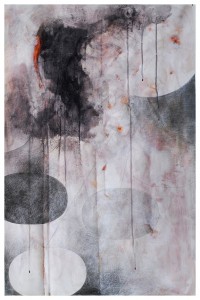
What is Imprinted Will Always Leave a Trace
Arnheim Gallery
January 21-31, 2013
Artist Talk: Wednesday January 30, 6:15 pm
Shireen Agah Yadollahpour, an alumna of our MSAE program, teaches at Needham High School.
See her website.
Artist Statement
As artists, we know the power of the visual. As educators, we understand that our words hold gravity, and the studio dynamic that we help shape has an impact on the learning experience of those students enrolled in our classes.
After fourteen years in the field, I began to reflect on the practice of my teaching. After so many lessons and units, I began to wonder—what has happened in my studio classroom that has resonated with students and helped them connect with their best selves? What words and actions left an impact on them? And, on a related note–how has my teaching practice informed my studio process and work? Curious, I sent out a call to many of my former students asking them the following question: What did you hear, see, or experience in our studio that left its mark on you? Their responses were informative in their honesty and revealing in their implications for the future of art education. They also made me reflect further on the responsibility that I hold as both a teacher and mother.
For this exhibit, I created a series of works in response to the words that my students wrote, and observations about teaching art in a post-constructive period. The structure of curriculum, the pressure of product versus process, and the struggle to find one’s individual voice became a common thread in the responses and observations. In the end, many pieces attempted to speak about the struggle between control and intuition, rigidity and flexibility, and denial and truthfulness. As a departure from my work in recent years, I focused less on a predetermined title that set the narrative but threatened the interpretation and dialogue through its rigid specificity. In these new works, I attempted a dance between both recognizable images and abstraction through the layered, textured surfaces of the pieces. Their construction began with grounds overlaid with dried, unfolded tea bags, found catalog cards, raw canvas, experimental monographs, and a few dressmaker patterns–all of which have an inherent sense of history and past function. Surfaces were then layered with paint, pencil, ink, charcoal, and sewing thread. Large areas of gestures, marks, and color are covered with sliding planes that reference some sense of structure, like test ovals, grids, and Venn diagrams, addressing the continuous challenge of finding balance between order and chaos when teaching art to others. This dichotomy hopefully translates to an audience that understands the difficulty inherent in designing meaningful, authentic, and individualistic studio art curriculum and learning experiences while still maintaining high standards of craft and technique. How do you honor the experimental and the spontaneous when the revised and sharply refined are evaluated, catalogued, and assessed by a number of authorities?
While the exhibit’s initial intentions were focused more on the impact of teaching practices, the process resulted in a personal reaffirmation of my role as a mentor and model for my students and my own children. If I spend such a large part of my teaching time encouraging others to take risks, experiment, and to conquer fears, it’s necessary for me to follow the same advice. It’s a struggle to find time to think about the work critically and make pieces regularly; yet, it’s essential to my growth and integrity that I try to, regardless of its reception.
